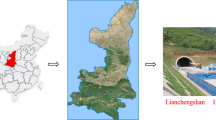Conclusion
The developed technique of predicting rock pressure and monitoring its manifestation in the lining by geophysical methods was introduced on the construction of the discharge tunnel of the Zhinvali hydrostation on stretches of argillaceous rocks with an intense rock pressure. The use of the set of geophysical methods made it possible during construction to refine the engineering-geological conditions and to give a prediction of the possible rock pressure on the undriven stretch of the tunnel route, in conformity with which the design of the lining was changed. Routine monitoring of manifestations of rock pressure and effectiveness of the strengthening measures on stabilizing deformations of the mass and lining was organized during the tunneling operations.
The given data indicate the practical possibilities of combined geophysical monitoring during construction of underground structures in naturally stressed masses under complex engineering-geological conditions.
Similar content being viewed by others
Literature cited
N. S. Bulychev, Mechanics of Underground Structures [in Russian], Nedra, Moscow (1982).
V. I. Grdzelishvili, A. V. Gotsadze, and K. V. Kobaladze, “Characteristics of the design and construction of underground structures of the Zhinvali hydroelectric station,” Énerg. Stroit., No. 5 (1985).
M. G. Ezerskii, M. S. Rudyak, V. V. Zhdanov, and T. N. Bochkareva, “Prerequisites and results of using the acoustic emission method for monitoring the development of rock pressure on the lining of hydraulic tunnels,” Tr. Gidroproekta, No. 122 (1987).
A. I. Savich, B. D. Kuyundzhich, et al. (eds.), Complex Engineering-Geophysical Investigations in the Construction of Hydraulic Structures [in Russian], Nedra, Moscow (1990).
A. K. Mastitskii and S. B. Kereselidze, “Detected deviation of engineering-geological conditions from those predicted at the sites of construction of the Inguri, Khudoni, and Zhinvali hydroelectric stations and analysis of the causes of their occurrence,” Tr. Gidroproekta, No. 136 (1989).
E. M. Pashkin, S. B. Kereselidze, A. K. Mastitskii, et al., “Engineering-geological conditions of construction of the Zhinvali hydroelectric station,” Énerg. Stroit., No. 5 (1985).
A. D. Chitanava, “Layout and design solutions for the Zhinvali multipurpose hydro development on the Aragvi River,” Énerg. Stroit., No. 5 (1985).
H. R. Hardy, R. Y. Kim, R. Stefanko, and Y. J. Wang, “Creep and microseismic activity in geological materials,” in: Proc. of the 11th Symp. on Rock Mech., Berkeley (1969), pp. 372–413.
Additional information
Translated from Gidrotekhnicheskoe Stroitel'stvo, No. 3, pp. 24–27, March, 1991.
Rights and permissions
About this article
Cite this article
Ezerskii, M.G., Rudyak, M.S. & Kobaladze, K.V. Prediction and monitoring of rock pressure in the discharge tunnel of the Zhinvali hydro development by geophysical methods. Hydrotechnical Construction 25, 134–140 (1991). https://doi.org/10.1007/BF01423975
Issue Date:
DOI: https://doi.org/10.1007/BF01423975




